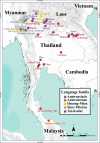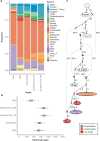Reconstructing the Human Genetic History of Mainland Southeast Asia: Insights from Genome-Wide Data from Thailand and Laos
- PMID:33905512
- PMCID: PMC8321548
- DOI: 10.1093/molbev/msab124
Reconstructing the Human Genetic History of Mainland Southeast Asia: Insights from Genome-Wide Data from Thailand and Laos
Abstract
Thailand and Laos, located in the center of Mainland Southeast Asia (MSEA), harbor diverse ethnolinguistic groups encompassing all five language families of MSEA: Tai-Kadai (TK), Austroasiatic (AA), Sino-Tibetan (ST), Hmong-Mien (HM), and Austronesian (AN). Previous genetic studies of Thai/Lao populations have focused almost exclusively on uniparental markers and there is a paucity of genome-wide studies. We therefore generated genome-wide SNP data for 33 ethnolinguistic groups, belonging to the five MSEA language families from Thailand and Laos, and analyzed these together with data from modern Asian populations and SEA ancient samples. Overall, we find genetic structure according to language family, albeit with heterogeneity in the AA-, HM-, and ST-speaking groups, and in the hill tribes, that reflects both population interactions and genetic drift. For the TK speaking groups, we find localized genetic structure that is driven by different levels of interaction with other groups in the same geographic region. Several Thai groups exhibit admixture from South Asia, which we date to ∼600-1000 years ago, corresponding to a time of intensive international trade networks that had a major cultural impact on Thailand. An AN group from Southern Thailand shows both South Asian admixture as well as overall affinities with AA-speaking groups in the region, suggesting an impact of cultural diffusion. Overall, we provide the first detailed insights into the genetic profiles of Thai/Lao ethnolinguistic groups, which should be helpful for reconstructing human genetic history in MSEA and selecting populations for participation in ongoing whole genome sequence and biomedical studies.
Keywords: Mainland Southeast Asia; South Asian admixture; cultural diffusion; genome-wide; population interaction.
© The Author(s) 2021. Published by Oxford University Press on behalf of the Society for Molecular Biology and Evolution.
Figures






References
- Anderson D. 1990. Lang Rong Rien rockshelter: a Pleistocene-early Holocene archaeological site from Krabi, Southwestern Thailand. Philadelphia: University of Pennsylvania Press.
- Baker C, Phongpaichit P.. 2017. A history of Ayutthaya. Cambridge: Cambridge University Press.
Publication types
MeSH terms
LinkOut - more resources
Full Text Sources
Other Literature Sources
